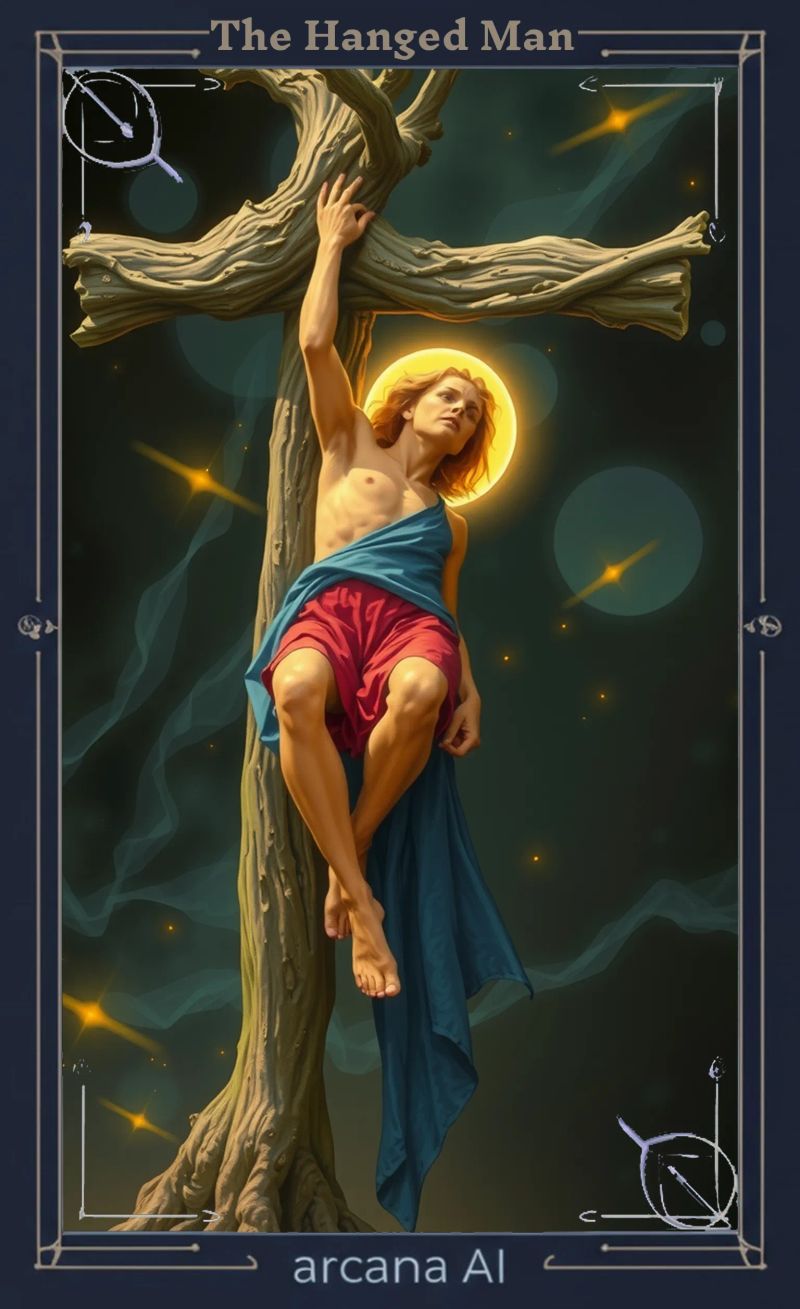The Hanged Man (XII)
Major Arcana - Card XII
The Hanged Man represents the profound spiritual principle of surrender, sacrifice, and enlightenment through suspension of normal patterns. This card embodies the mystical understanding that sometimes we must let go of our ego-driven perspectives and allow ourselves to be transformed by seeing the world from a completely different angle.
Upright Meaning
When The Hanged Man appears upright in a reading, it signifies a voluntary surrender, a necessary pause, or a period of suspension. You are being called to release your attachment to a particular outcome and allow a higher wisdom to guide the situation. This card suggests that enlightenment comes through letting go rather than forcing solutions.
Key Themes:
- Voluntary surrender and sacrifice
- New perspectives and paradigm shifts
- Suspension of normal patterns
- Spiritual enlightenment through letting go
- The wisdom of patient waiting
Practical Applications: In times of transition or difficulty, The Hanged Man advises releasing control and allowing the situation to unfold naturally. For spiritual growth, it suggests meditation, contemplation, or retreat from worldly concerns. In relationships, it may indicate a need to let go of rigid expectations.
Reversed Meaning
When reversed, The Hanged Man can indicate resistance to necessary change, martyrdom, or unnecessary delays. You may be clinging to outdated perspectives or avoiding the surrender needed for growth.
Key Themes:
- Resistance to change or surrender
- Martyrdom or victim mentality
- Unnecessary delays or stagnation
- Clinging to outdated perspectives
- Avoidance of spiritual growth opportunities
Shadow Work: The reversed Hanged Man calls for examining where you may be resisting necessary changes or playing the martyr. It may indicate a need to release victim consciousness and embrace personal responsibility.
Symbolism and Imagery
The Rider-Waite-Smith depiction of The Hanged Man shows a figure suspended upside down from a living tree, one leg crossed behind the other in the shape of a cross. The figure’s hands are positioned behind the back, and the head is surrounded by a golden halo. The scene is peaceful, with distant mountains visible in the background.
The Suspension: The upside-down position represents a complete reversal of normal perspective and the suspension of ego-driven thinking. This voluntary sacrifice symbolizes the surrender of personal will to divine wisdom and the acceptance of a higher order.
The Tree: The living tree represents the World Tree or Tree of Life, connecting heaven and earth. The Hanged Man’s position on the tree suggests crucifixion and resurrection symbolism, indicating that sacrifice leads to spiritual rebirth and enlightenment.
The Crossed Leg: The figure’s leg forms the shape of the number 4, symbolizing stability and foundation. This crossed position also resembles the alchemical symbol for sulfur, representing the transformative power of sacrifice.
The Colors:
- Blue clothing: Spiritual devotion and divine contemplation
- Red leggings: Passion and life force, grounded in sacrifice
- Golden halo: Spiritual enlightenment and divine wisdom
- Green trees: Growth, renewal, and the living nature of spiritual evolution
Symbolic Elements:
- Inverted position: Complete paradigm shift and new perspective
- Peaceful expression: Acceptance and transcendence of suffering
- T-shaped tree: Tau cross, symbolizing sacrifice and redemption
Historical Context
The Hanged Man draws from multiple mystical and religious traditions. The image of the hanged god appears in Norse mythology (Odin hanging from Yggdrasil) and Celtic traditions. The card also resonates with the mystical concept of the “fool’s pilgrimage” and the necessary sacrifice for spiritual growth.
In the Rider-Waite-Smith tradition, The Hanged Man is associated with the Hebrew letter Mem (מ) and represents the principle of sacrifice and the suspension of material concerns for spiritual development. The card embodies the understanding that true wisdom often requires letting go of our preconceived notions.
Card Combinations and Interactions
With Death: Amplifies themes of profound transformation and the need to release old patterns of being.
With The Tower: Suggests that voluntary surrender can help navigate sudden, disruptive changes.
With The Hermit: Indicates a period of deep introspection and spiritual retreat for gaining new perspectives.
With The Lovers: May suggest that relationship decisions require surrendering personal desires for a higher good.
With Temperance: Creates a powerful combination emphasizing balance through surrender and spiritual alchemy.
Astrological and Elemental Correspondences
Astrological Sign: Pisces - The sign of surrender, spirituality, and transcendence. Pisces’ association with The Hanged Man emphasizes compassion, intuition, and the dissolution of ego boundaries.
Element: Water - Representing emotions, intuition, and the flow of consciousness. The water element in The Hanged Man is still and deep, like a sacred pool reflecting divine wisdom.
Planet: Neptune - The planet of spirituality, illusion, and transcendence. Neptune’s influence suggests the dissolution of material attachments and the embrace of spiritual realities.
Hebrew Letter: Mem (מ) - Meaning “water,” representing the primordial waters of creation, the subconscious mind, and the fluid nature of spiritual transformation.
Explore More
Discover deeper insights about this card by using the Arcana AI app for personalized tarot readings tailored to your specific situation and question.
